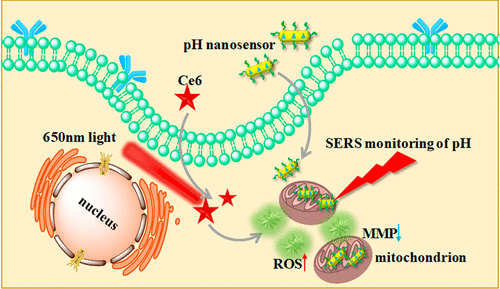当前位置:
X-MOL 学术
›
Anal. Chem.
›
论文详情
Our official English website, www.x-mol.net, welcomes your feedback! (Note: you will need to create a separate account there.)
Revealing Mitochondrial Microenvironmental Evolution Triggered by Photodynamic Therapy.
Analytical Chemistry ( IF 7.4 ) Pub Date : 2020-04-02 , DOI: 10.1021/acs.analchem.0c00497 Jing Yue 1 , Yanting Shen 1 , Lijia Liang 1 , Lili Cong 1 , Weiqing Xu 1 , Wei Shi 2 , Chongyang Liang 3 , Shuping Xu 1
Analytical Chemistry ( IF 7.4 ) Pub Date : 2020-04-02 , DOI: 10.1021/acs.analchem.0c00497 Jing Yue 1 , Yanting Shen 1 , Lijia Liang 1 , Lili Cong 1 , Weiqing Xu 1 , Wei Shi 2 , Chongyang Liang 3 , Shuping Xu 1
Affiliation

|
Mitochondrion is one of the most important organelles and becomes a target in many cancer therapeutic strategies. Mitochondrial microenvironments in response to therapeutic methods are the key to understand therapeutic mechanisms. However, they are almost rarely studied. Herein, the mitochondrial microenvironments, including mitochondrial membrane potential (MMP) and reactive oxygen species (ROS) after different photodynamic therapy (PDT) dosages, were monitored by fluorescent imaging and compared among three cell lines (HepG2, MCF-7, and LO2). Furthermore, the fluctuations of intramitochondrial pHs were revealed via a plasmonic mitochondrion-targeting surface-enhanced Raman scattering (SERS) pH nanosensor. Results indicate that the MMP decreases gradually with the ROS generation and the cancerous cells exhibit less response to excess ROS relative to normal cells. On the other hand, the pH value in the mitochondria decreases initially and then increases when the amount of ROS increases. The LO2 cell is preliminarily evidenced to have a higher self-adjustment ability due to its better tolerance to differential intra/extracellular pHs. This study may provide a basis for an in-depth understanding of the mechanisms of the mitochondrial targeting-based PDT therapeutic processes. It is also helpful for more accurate and useful diagnosis according to intramitochondrial microenvironments and improvement on therapy efficiency of cancers.
中文翻译:

揭示由光动力疗法触发的线粒体微环境进化。
线粒体是最重要的细胞器之一,并成为许多癌症治疗策略的靶标。响应治疗方法的线粒体微环境是了解治疗机制的关键。但是,几乎很少研究它们。本文中,通过荧光成像监测不同光动力疗法(PDT)剂量后的线粒体微环境,包括线粒体膜电位(MMP)和活性氧(ROS),并比较了三种细胞系(HepG2,MCF-7和LO2) 。此外,线粒体内pH的波动是通过等离子线粒体靶向表面增强拉曼散射(SERS)pH纳米传感器揭示的。结果表明,相对于正常细胞,MMP随着ROS的产生而逐渐降低,癌细胞对过量ROS的反应较小。另一方面,线粒体中的pH值先降低,然后随着ROS量的增加而增加。初步证明,LO2细胞具有更高的自我调节能力,因为它对不同的细胞内/细胞外pH具有更好的耐受性。这项研究可为深入了解基于线粒体靶向的PDT治疗过程的机制提供基础。它还有助于根据线粒体内微环境进行更准确和有用的诊断,并改善癌症的治疗效率。线粒体中的pH值先下降,然后随着ROS的增加而增加。初步证明,LO2细胞具有更高的自我调节能力,因为它对不同的细胞内/细胞外pH具有更好的耐受性。这项研究可为深入了解基于线粒体靶向的PDT治疗过程的机制提供基础。它还有助于根据线粒体内微环境进行更准确和有用的诊断,并改善癌症的治疗效率。线粒体中的pH值先下降,然后随着ROS的增加而增加。初步证明,LO2细胞具有更高的自我调节能力,因为它对不同的细胞内/细胞外pH具有更好的耐受性。这项研究可为深入了解基于线粒体靶向的PDT治疗过程的机制提供基础。它还有助于根据线粒体内微环境进行更准确和有用的诊断,并改善癌症的治疗效率。这项研究可为深入了解基于线粒体靶向的PDT治疗过程的机制提供基础。它还有助于根据线粒体内微环境进行更准确和有用的诊断,并提高癌症的治疗效率。这项研究可为深入了解基于线粒体靶向的PDT治疗过程的机制提供基础。它还有助于根据线粒体内微环境进行更准确和有用的诊断,并改善癌症的治疗效率。
更新日期:2020-04-23
中文翻译:

揭示由光动力疗法触发的线粒体微环境进化。
线粒体是最重要的细胞器之一,并成为许多癌症治疗策略的靶标。响应治疗方法的线粒体微环境是了解治疗机制的关键。但是,几乎很少研究它们。本文中,通过荧光成像监测不同光动力疗法(PDT)剂量后的线粒体微环境,包括线粒体膜电位(MMP)和活性氧(ROS),并比较了三种细胞系(HepG2,MCF-7和LO2) 。此外,线粒体内pH的波动是通过等离子线粒体靶向表面增强拉曼散射(SERS)pH纳米传感器揭示的。结果表明,相对于正常细胞,MMP随着ROS的产生而逐渐降低,癌细胞对过量ROS的反应较小。另一方面,线粒体中的pH值先降低,然后随着ROS量的增加而增加。初步证明,LO2细胞具有更高的自我调节能力,因为它对不同的细胞内/细胞外pH具有更好的耐受性。这项研究可为深入了解基于线粒体靶向的PDT治疗过程的机制提供基础。它还有助于根据线粒体内微环境进行更准确和有用的诊断,并改善癌症的治疗效率。线粒体中的pH值先下降,然后随着ROS的增加而增加。初步证明,LO2细胞具有更高的自我调节能力,因为它对不同的细胞内/细胞外pH具有更好的耐受性。这项研究可为深入了解基于线粒体靶向的PDT治疗过程的机制提供基础。它还有助于根据线粒体内微环境进行更准确和有用的诊断,并改善癌症的治疗效率。线粒体中的pH值先下降,然后随着ROS的增加而增加。初步证明,LO2细胞具有更高的自我调节能力,因为它对不同的细胞内/细胞外pH具有更好的耐受性。这项研究可为深入了解基于线粒体靶向的PDT治疗过程的机制提供基础。它还有助于根据线粒体内微环境进行更准确和有用的诊断,并改善癌症的治疗效率。这项研究可为深入了解基于线粒体靶向的PDT治疗过程的机制提供基础。它还有助于根据线粒体内微环境进行更准确和有用的诊断,并提高癌症的治疗效率。这项研究可为深入了解基于线粒体靶向的PDT治疗过程的机制提供基础。它还有助于根据线粒体内微环境进行更准确和有用的诊断,并改善癌症的治疗效率。

























 京公网安备 11010802027423号
京公网安备 11010802027423号